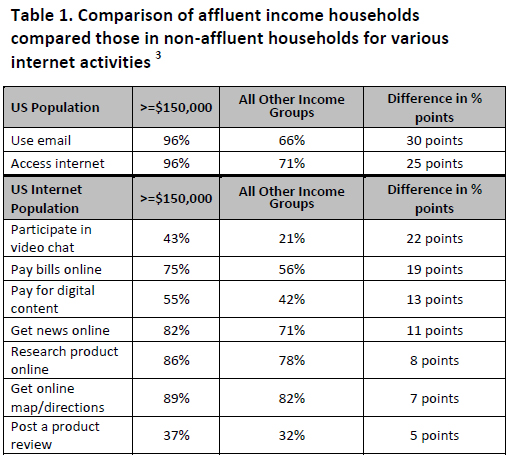Those in higher-income households are different from other Americans in their tech ownership and use.
95% of those in households earning over $75,000 use the internet and cell phones
Those in higher-income households are more likely to use the internet on any given day, own multiple internet-ready devices, do things involving money online, and get news online
Those in higher-income households are different from other Americans in their tech ownership and use.
Analysis of several recent surveys conducted by the Pew Research Center’s Internet & American Life Projects find that there are key differences between those who live in households making $75,000 or more relative to those in lower-income households.
Some 95% of Americans who live in households earning $75,000 or more a year use the internet at least occasionally, compared with 70% of those living in households earning less than $75,000.
Even among those who use the internet, the well off are more likely than those with less income to use technology. Of those 95% of higher-income internet users:
- 99% use the internet at home, compared with 93% of the internet users in lower brackets.
- 93% of higher-income home internet users have some type of broadband connection versus 85% of the internet users who live in households earning less than $75,000 per year. That translates into 87% of all those in live in those better-off households having broadband at home.
- 95% of higher-income households own some type of cell phone compared with 83% in households with less income.
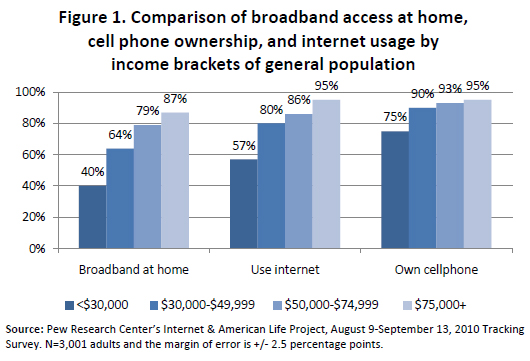
The differences among income cohorts apply to other technology as well
The relatively well-to-do are also more likely than those in lesser-income households to own a variety of information and communications gear.3
- 79% of those living in households earning $75,000 or more own desktop computers, compared with 55% of those living in less well-off homes.
- 79% of those living in higher-income households own laptops, compared with 47% of those living in less well-off homes.
- 70% of those living in higher-income households own iPods or other MP3 players, compared with 42% of those living in less well-off homes.
- 54% of those living in higher-income households own game consoles, compared with 41% of those living in less well-off homes.
- 12% of those living in higher-income households own e-book readers such as Kindles, compared with 3% of those living in less well-off homes.
- 9% of those living in higher-income households own tablet computers such as iPads, compared with 3% of those living in less well-off homes.
Background of this analysis
The findings in this report come from three surveys by the Pew Internet Project conducted in late 2009 and 2010. In each of those surveys, respondents were asked if their household income fell into certain ranges. As in Pew Internet surveys in the past, many respondents were willing to provide income ranges for their household. Still, in each survey a notable number of respondents said they did not want to disclose their income: 17% in the survey in December 2009 – January 2010 did not disclose their income1; 16% in the April – May 2010 survey did not disclose their income2; and 14% in the August – September 2010 survey did not do so3.
The analysis in this report covers the responses of those who did disclose their income.
Those with higher-incomes engage in most online activities more frequently
These recent Pew Internet surveys show that the internet users in the higher-income households are the most active participants in a range of online activities, when compared with those who have less income:
- 93% of higher-income users use email3
- 80% access news online3
- 71% pay bills online3
- 48% have used their cell to send or receive email1
- 88% conduct online product research3
- 37% have donated to charities online2
The internet users in higher-income households are more likely than others to go online multiple times a day, both at home and at work. Some 86% of internet users in higher-income households go online daily, compared with 54% in the lowest income bracket.
In many cases, the most noticeable difference in online engagement between various income groups relates to their intensity of use. On any given day, the internet users in the higher-income bracket are more likely than the internet users in lower-income brackets to be doing various online activities. Compared with internet users in other income cohorts, higher-income internet users go online more often compared with other groups: For instance, 55% are on the internet or are using email several times a day from home. Moreover, the more well-to-do internet users, on any given day are more likely get online news, conduct online research for a product or service, and go online to search for maps or directions.3
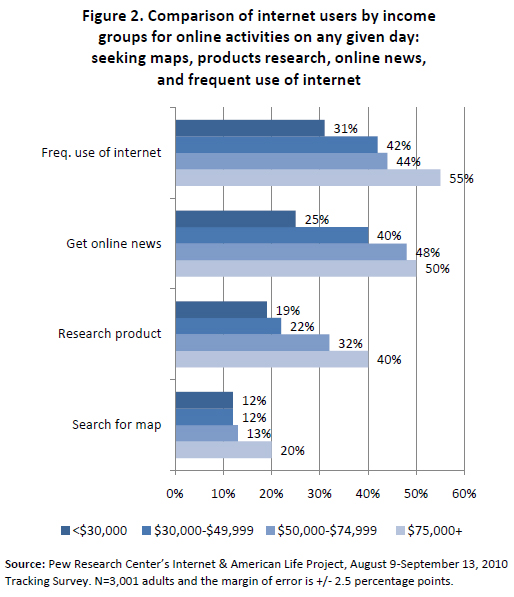
Where better-off Americans get their news
Those who fall in the top earnings category are also the biggest consumers of online news sources, with 80% of higher-income internet users (74% of the general population) seeking news on the internet.3
However, the higher-income households have not abandoned traditional media altogether; they also turn to print and television, especially for local news. Asked about various platforms where they might get the news on a typical day, 76% o those from higher-income households watch local and national news shows on television, 51% of this higher-income group said they get local news from a print version of a newspaper, and 22% read a print version of a newspaper for national news.1
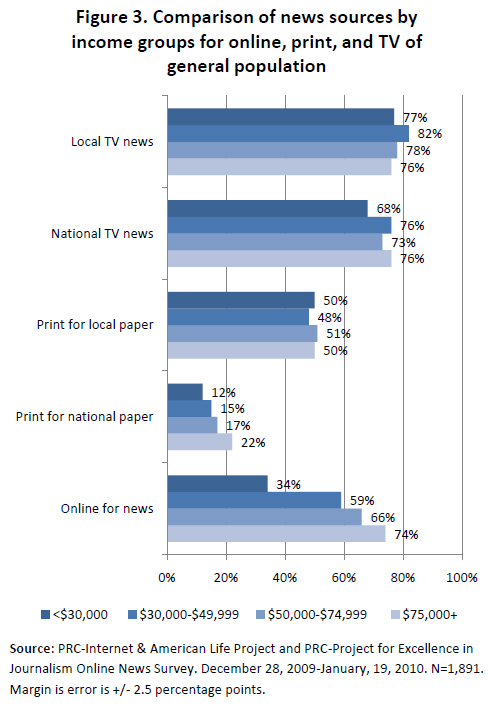
Yet, the online news consumption patterns of this more well off group stand in stark contrast to those living in the lowest income households.1, 2, 3
- 80% of online Americans in the higher income bracket get news on the internet, compared with 60% of the internet users earning less than $30,000 per year3
- 79% of the internet users in the higher earning bracket have visited a government website at the local, state or federal level versus 56% of those who fall into the lowest-income group2
- 61% in the higher bracket seek political news online, compared with 35% from the lowest-income bracket2
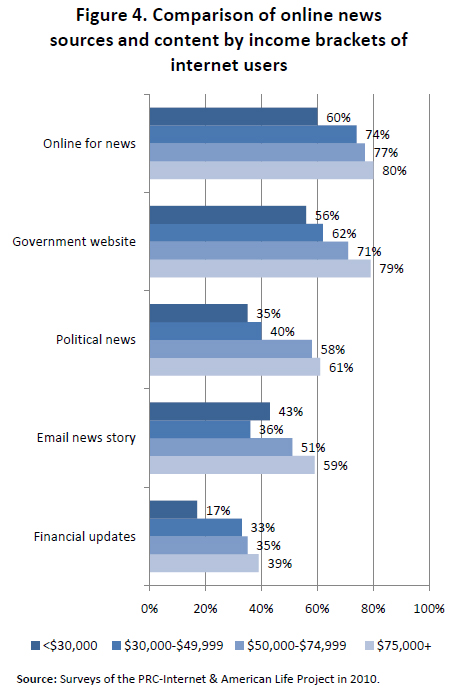
Wealth and health information-seeking go hand-in-hand
Online Americans in the higher-income bracket are fully engaged with seeking heath information and conducting other health-related activities online.3 Internet users in the top income brackets are more likely to search for medical information online, seek treatment information, seek material about doctors and medical facilities, and get data concerning test results.
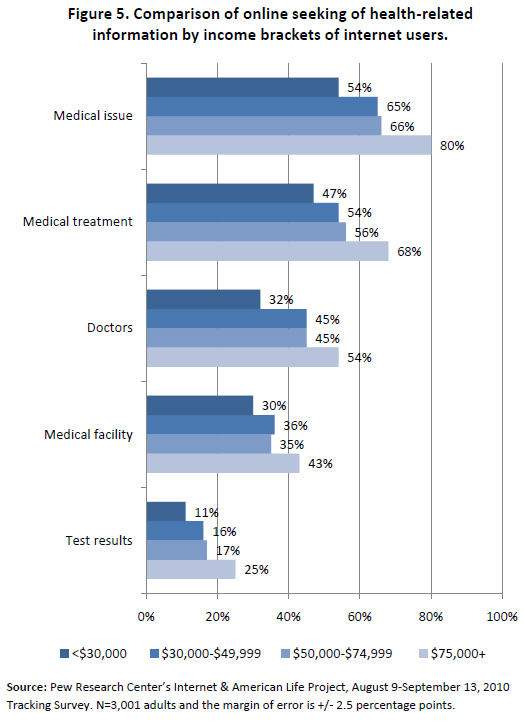
Engagement with online commerce by the higher-income households
Significantly more higher-income Americans are conducting e-commerce activities than members of other income groups.
Solid majorities of higher-income internet users research products (88%), make travel reservations online (83%), purchase products or services online (81%), perform online banking (74%), use the internet to pay bills (71%), and use online classified sites such as Craigslist (60%).1, 2, 3
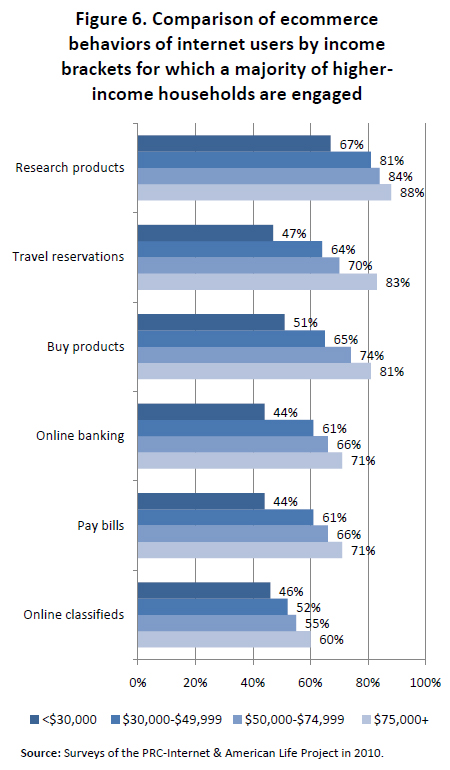
There are other e-commerce activities for which less than a majority of higher-income Americans on the internet engage, but they still conduct these activities at significantly higher percentages than other income groups, including paying for online content, reviewing products, rating products, and participating on online auctions.2, 3
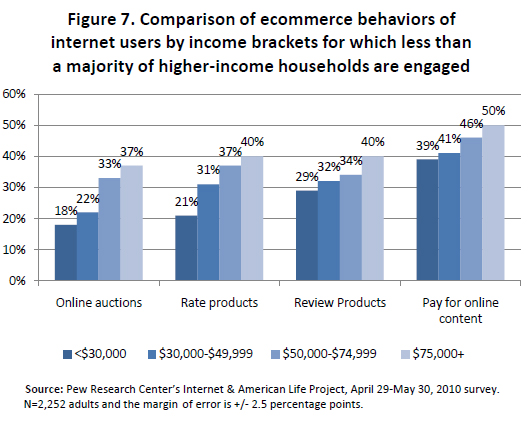
Use of internet-ready devices by higher-income households
Relatively prosperous Americans have multiple internet and other devices, with higher ownership of cell phones (95%), desktop and laptop computers (79% each), mp3 players (70%), and game consoles (54%) relative to other income groups.3
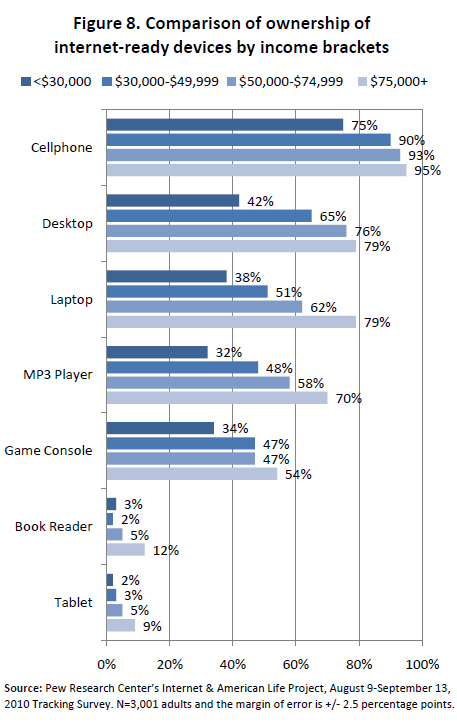
Other possible contributing factors: community type, educational attainment, race and ethnicity, gender, and age
We examined several controlling factors in examining internet adoption, including community type (rural, suburban, urban), education (some high school, high school, some college, college graduate), race (White, African-American, Hispanic, Other), gender, and age (divided into generational groups of Generation Y (ages 18-33), Generation X (ages 34-45), Trailing Boomers (ages 46-55), Leading Boomers (ages 56-64), Matures (ages 65-73), and After Work (age 74+).3
Regardless of the control factor, those in the higher-income bracket were statistically significantly more likely to be internet and email users than those in the other income brackets with the same control factor. In nearly all cases, the practical effect of the control factor was minor: That is, the control factor did not add major explanatory effect to the relationship that was not explained by income level. Simply put, a person’s household income is an independent predictor of the likelihood that she or he will be an internet and email user and to be associated with the online activities we cite in this report.
Use of internet
Concerning the use of the internet, differences involving gender, race, and educational level had no practical impact on internet use by income level.
Those living in suburban and urban areas are slightly more likely to be internet users than their rural counterparts.
There were also minor differences among the age groupings, especially with Trailing Boomers (ages 46-55) and Matures (ages 65-73), with larger percentages of these age groups using the internet when compared with those in the same age groups from lower-income households.
However, with both community type and age, the differences were slight relative to what could be explained just by household income.
Use of email
We performed the same analysis for email usage. Again, most of these controlling factors were not substantial contributors to differences in whether someone was an email user or not.
Gender, race, and educational level had no practical impact on email use.
Those living in suburban and urban areas use email slightly more than their rural counterparts, although the differences were very slight.
With age, we again found that there were minor differences among the age groupings, specifically with Gen X (ages 34-45), Trailing Boomers (ages 46-55) and Matures (ages 65-73), with larger percentages of these age groupings in the higher-income using email than those in the same age groupings from lower-income households. Again, the practical differences were slight indicating that age was not a major contributing factor.
A look at the even more well-to-do: Those in households earning $150,000 or more
Given that $75,000 is only about one and half times the median household income of $49,777 4, we also examined those in the higher-income brackets exclusively.3 In the August-September 2010 Pew Internet survey there were 142 respondents who reported living in households earning $150,000 or more, which is the dataset used for this analysis.
Examining those living in households with an income of $150,000 or more, there are significant differences with the other income groups. The affluent are significantly more likely to use the internet (30% more) and email (25% more) than the rest of the American population.
Looking more closely at internet users, the affluent are more likely than other internet users to participate in video chat (22% more likely), pay bills online (19%) and get online news (11%).
In fact, technology saturates the lives of affluent Americans. Nearly all (96%) of this affluent demographic use the internet or email. Nine in ten (89%) of the high-income internet users have searched online for maps or directions, 86% have researched a product online, and 82% get a portion of their news online.
